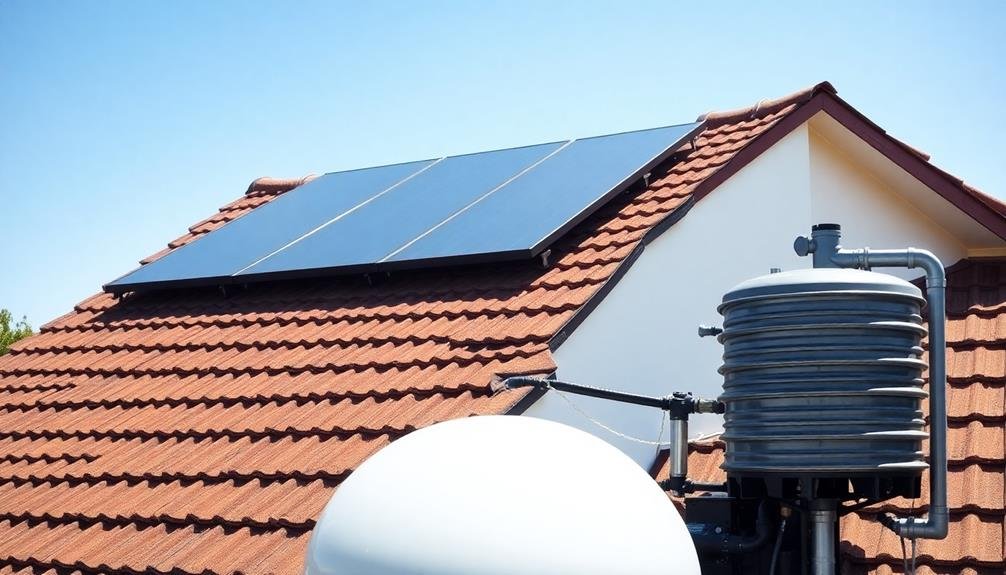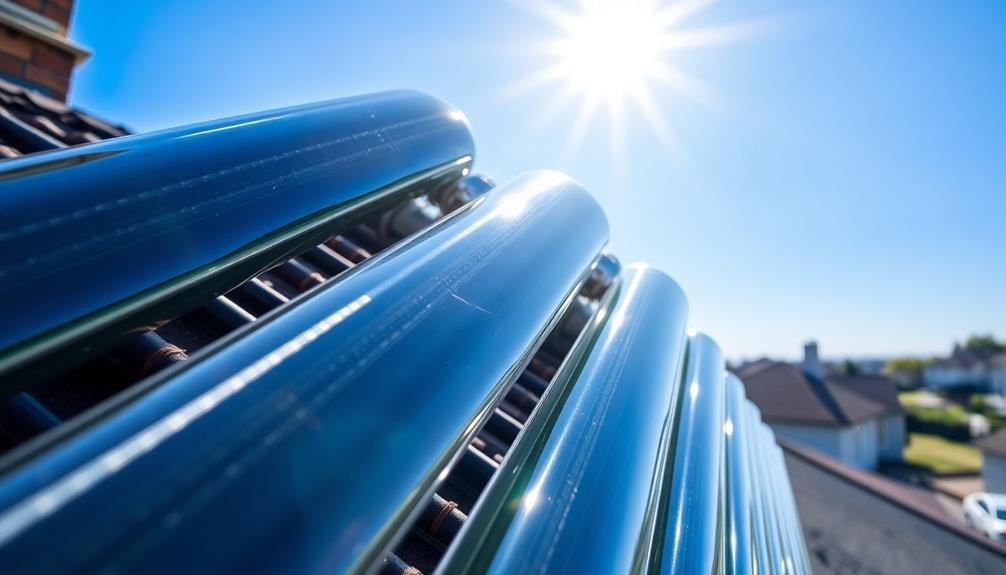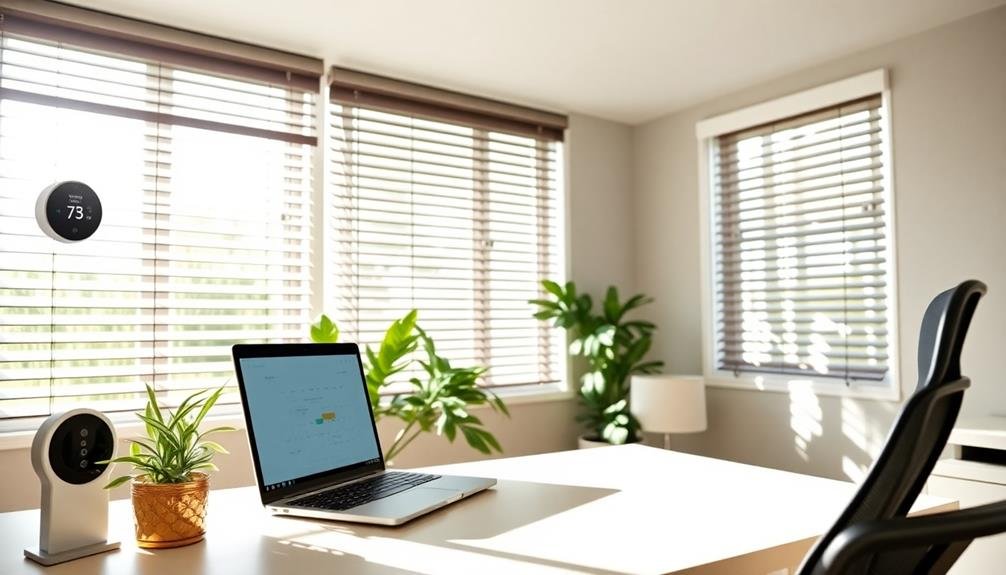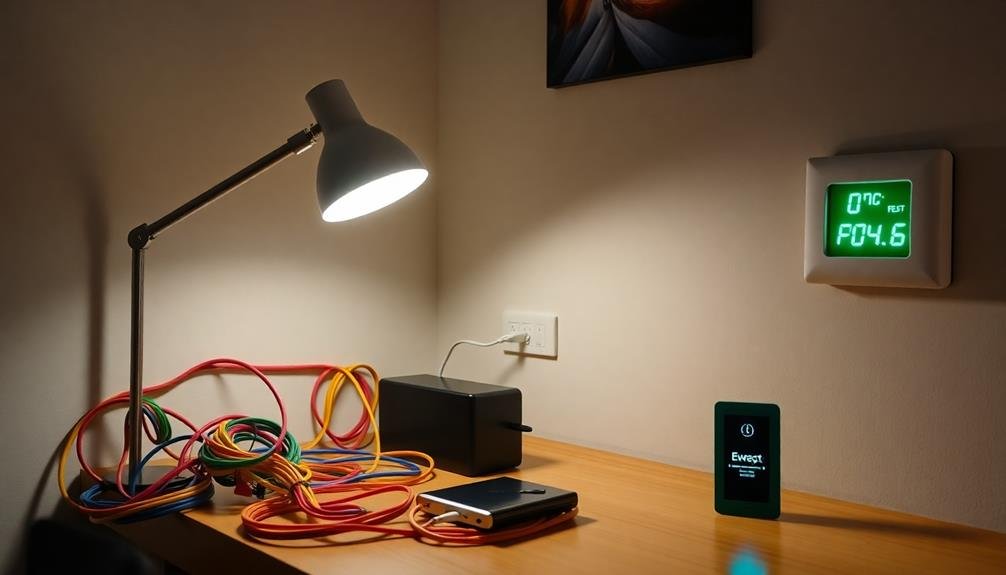Five popular solar water heater plans for home projects include passive batch, thermosiphon, active direct circulation, integral collector-storage, and evacuated tube systems. You'll find options ranging from simple DIY setups to more advanced configurations. Passive batch heaters are cost-effective and easy to build, while thermosiphon systems use natural convection for water circulation. Active direct circulation heaters offer higher efficiency, and integral collector-storage units combine the collector and tank. For maximum performance, consider evacuated tube collectors, which work well even in cold or cloudy conditions. Each system has unique benefits, and understanding their differences will help you choose the best fit for your home.
Passive Batch Solar Water Heater

Passive batch solar water heaters are often the simplest and most cost-effective solar water heating systems. They consist of one or more storage tanks placed in an insulated box with a glazed side facing the sun. As sunlight passes through the glazing, it heats the water inside the tanks.
To build a passive batch heater, you'll need a large, dark-colored tank, an insulated box, and a sheet of glazing material like tempered glass or polycarbonate. Start by constructing the insulated box using plywood and rigid foam insulation. Place the tank inside and guarantee it's well-supported.
Install the glazing on the south-facing side of the box, leaving an air gap between it and the tank. You'll want to connect the heater to your home's plumbing system. Install inlet and outlet pipes, making sure to include a tempering valve to prevent scalding.
For freeze protection in colder climates, consider a drain-back system or heat exchanger. While passive batch heaters are less efficient than active systems, they're easier to build and maintain. They work best in moderate climates and for households with daytime hot water needs.
Thermosiphon Solar Water Heating System
Unlike passive batch systems, thermosiphon solar water heaters rely on natural convection to circulate water without pumps. These systems are more efficient and can provide hot water throughout the day and night.
To set up a thermosiphon system, you'll need to place the solar collector below the storage tank. As water in the collector heats up, it becomes less dense and rises naturally into the tank, while cooler water from the tank flows down to replace it.
When designing your thermosiphon system, consider these key factors:
- Collector tilt angle: Optimize for your latitude and seasonal sun angles
- Pipe insulation: Minimize heat loss in the circulation loop
- Tank placement: guarantee it's higher than the collector for proper flow
- Freeze protection: Use antifreeze or drain-back systems in cold climates
You'll find that thermosiphon systems are relatively simple to install and maintain. They're ideal for areas with reliable sunlight and moderate climates.
Active Direct Circulation Heater

Active direct circulation heaters offer a more advanced approach to solar water heating. These systems use pumps to circulate water directly through the solar collectors, making them more efficient than passive systems.
You'll find they're ideal for regions where freezing isn't a concern, as the water flows directly through the collectors and into your home's plumbing.
To build an active direct circulation heater, you'll need solar collectors, a pump, a controller, and insulated piping. Start by mounting the collectors on your roof, ensuring they face the sun for maximum exposure.
Connect the collectors to your existing water heater using insulated pipes. Install the pump between the water heater and the collectors to circulate water through the system. The controller monitors temperatures and activates the pump when the collectors are warmer than the water in the tank.
You'll need to size the system based on your household's hot water needs and local climate conditions. Remember to include a backup heating element for cloudy days.
While more complex than passive systems, active direct circulation heaters can provide a significant portion of your home's hot water needs, reducing your energy bills and carbon footprint.
Integral Collector-Storage Solar Water Heater
Integral collector-storage solar water heaters combine the collector and storage tank into a single unit, offering a simple and compact solution for solar water heating.
These systems, also known as batch or breadbox heaters, are ideal for areas with mild freezing conditions and high hot water demand during the day and evening.
You'll find that integral collector-storage heaters are relatively easy to install and maintain. They work by exposing dark-colored tanks or tubes to the sun, which directly heat the water inside. As you use hot water, cold water enters the collector, replacing the heated water that flows into your home.
When considering this type of solar water heater, keep these key points in mind:
- They're most effective in warm climates with ample sunlight
- They typically don't require pumps or controllers, reducing complexity
- You'll need to guarantee proper insulation to minimize heat loss at night
- They may require a backup system for cloudy days or high demand periods
While integral collector-storage heaters are less efficient than active systems, they're often more affordable and easier to implement.
You'll find them particularly useful for small-scale applications or as preheating systems for conventional water heaters.
Evacuated Tube Solar Collector

Harnessing advanced technology, evacuated tube solar collectors offer a highly efficient solution for solar water heating. These systems consist of parallel rows of glass tubes, each containing a heat pipe surrounded by a vacuum. The vacuum acts as an excellent insulator, minimizing heat loss and allowing the collector to perform well even in cold or cloudy conditions.
To build an evacuated tube solar collector, you'll need to purchase pre-manufactured tubes, as creating a vacuum at home isn't practical. Mount the tubes on a frame angled towards the sun, typically at your latitude plus 15 degrees. Connect the heat pipes to a manifold at the top, which transfers heat to your water system.
The heat pipe inside each tube contains a small amount of fluid that vaporizes when heated by the sun. This vapor rises to the top of the tube, where it condenses and transfers heat to the water flowing through the manifold. The cooled fluid then returns to the bottom of the tube, repeating the cycle.
You'll find that evacuated tube collectors are more efficient than flat-plate collectors, especially in colder climates. They're also less prone to damage from freezing.
Frequently Asked Questions
How Much Money Can I Save Annually With a Solar Water Heater?
You can save $200-$600 annually with a solar water heater, depending on your location, energy costs, and hot water usage. It'll reduce your energy bills by 50-80% and pay for itself in 5-10 years.
What Maintenance Is Required for a Solar Water Heating System?
You'll need to perform regular maintenance on your solar water heating system. Check for leaks, inspect insulation, clean collectors, and test the antifreeze solution annually. You should also flush the system and replace worn parts as needed.
Can Solar Water Heaters Work Effectively in Colder Climates?
Yes, solar water heaters can work in colder climates. You'll need to use freeze-resistant systems and guarantee proper insulation. While they're less efficient in winter, they'll still provide significant energy savings throughout the year.
How Long Does It Typically Take to Install a Solar Water Heater?
You'll typically need 1-3 days to install a solar water heater. It depends on your system's complexity, your home's layout, and your experience level. Professional installers can often complete the job in a single day.
Are There Government Incentives or Rebates for Installing Solar Water Heaters?
Yes, you'll often find government incentives and rebates for solar water heaters. Check with your local and state authorities, as well as federal programs. They can offer tax credits, grants, or direct rebates to offset installation costs.
In Summary
You've now got five excellent solar water heater plans to choose from for your home project. Whether you opt for a simple passive batch system or a more advanced evacuated tube collector, you'll be harnessing the sun's energy to heat your water efficiently. Don't forget to take into account your climate, budget, and skill level when selecting a design. With a bit of effort, you'll soon be enjoying eco-friendly hot water and lower energy bills.





Leave a Reply